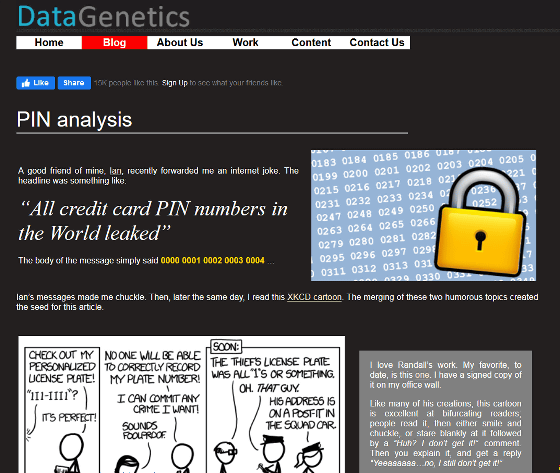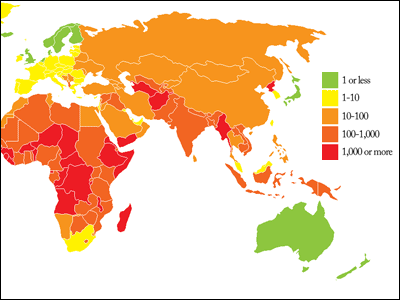What is the most commonly used 4-digit PIN?

There are many opportunities to use 'four-digit PIN numbers' in our daily lives, such as credit card PIN numbers, smartphone passcodes, and PC unlock codes. In all cases, we should use four-digit numbers that are difficult for others to guess, but many people use numbers that are easy to remember or type. In 2012, British data scientist Nick Berry wrote a blog that summarizes the numbers commonly used in four-digit PIN numbers, and the content is still interesting and relevant in 2024.
PIN number analysis

There are 10,000 possible four-digit PIN codes, each made up of the numbers 0-9. If everyone chose their numbers randomly, the chances of unlocking a phone by entering a random number would be just 0.01%.
However, only a minority of people actually use random PINs, and people tend to choose numbers that are easy to remember or enter. Therefore, a malicious person may be able to unlock a phone by entering a 'four-digit PIN that is particularly frequently used' with less time and effort than if they were to enter it randomly.
Berry analyzed a total of about 3.4 million four-digit PINs based on password data leaked from online services, etc. The top 20 most commonly used PINs were as follows:
| Ranking | PIN | ratio |
|---|---|---|
| First place | 1234 | 10.713% |
| No.2 | 1111 | 6.016% |
| 3rd place | 0000 | 1.881% |
| 4th | 1212 | 1.197% |
| No.5 | 7777 | 0.745% |
| No.6 | 1004 | 0.616% |
| 7th place | 2000 | 0.613% |
| No.8 | 4444 | 0.526% |
| No.9 | 2222 | 0.516% |
| 10th | 6969 | 0.512% |
| No.11 | 9999 | 0.451% |
| 12th place | 3333 | 0.419% |
| 13th place | 5555 | 0.395% |
| No.14 | 6666 | 0.391% |
| 15th place | 1122 | 0.366% |
| 16th place | 1313 | 0.304% |
| No.17 | 8888 | 0.303% |
| No.18 | 4321 | 0.293% |
| No.19 | 2001 | 0.290% |
| No.20 | 1010 | 0.285% |
The most popular four-digit PIN code was '1234,' accounting for a staggering 10.713% of all PIN codes. This is an incredibly high number considering that the rate for random selection is 0.01%. In second place was '1111' with 6.016%, and in third place was '0000' with 1.881%. The top 20 PIN codes accounted for a staggering 26.83% of all PIN codes.
The most frequently used PIN numbers were sequences of the same numbers such as '1111' and '2222', repetitions of two numbers such as '1212' and '6969', and consecutive numbers such as '1234' and '4321'. Other notable PIN numbers include '2001' which ranked 19th, '1984' which ranked 26th, and '0007' which ranked 23rd, thought to be a reference to the 007 series .
Among the puzzling PIN numbers Berry encountered early on was the 22nd-place number '2580.' After thinking about it for a while, Berry realized that the numbers were arranged from top to bottom on a mobile phone keypad. This keypad arrangement is also used for ATM terminals, so it seems that many people use their mobile phone and credit card passcodes for other Internet services.

As you can see from the table above, some popular numbers are used far more than others when it comes to 4-digit PINs. The most popular number, '1234,' is used more than the bottom 4,200 least popular numbers combined. In fact, if you enter the 1st to 5th most popular PINs, you can crack over 20% of all 4-digit PINs.
The graph below shows the frequency distribution of four-digit PINs. Statistically, one-third of all PINs can be broken by trying just 61 combinations, and 50% of all PINs can be broken by trying 426 combinations.

Conversely, here is a table of the least used 4-digit PIN numbers. The least popular number in the dataset obtained by Berry was '8068,' with only 25 of the 3.4 million numbers. In terms of percentage, this is '0.000744%,' which is much lower than the '0.01%' for random numbers.
| Ranking | PIN | ratio |
|---|---|---|
| 9981st place | 9047 | 0.001161% |
| 9982nd place | 8438 | 0.001161% |
| 9983rd place | 0439 | 0.001161% |
| 9984th place | 9539 | 0.001161% |
| 9985th place | 8196 | 0.001131% |
| 9986th place | 7063 | 0.001131% |
| 9987th place | 6093 | 0.001131% |
| 9988th place | 6827 | 0.001101% |
| 9989th place | 7394 | 0.001101% |
| 9990th place | 0859 | 0.001072% |
| 9991th place | 8957 | 0.001042% |
| 9992th place | 9480 | 0.001042% |
| 9993th place | 6793 | 0.001012% |
| 9994th place | 8398 | 0.000982% |
| 9995th place | 0738 | 0.000982% |
| 9996th place | 7637 | 0.000953% |
| 9997th place | 6835 | 0.000953% |
| 9998th place | 9629 | 0.000953% |
| 9999th place | 8093 | 0.000893% |
| 10,000th place | 8068 | 0.000744% |
In addition, the graph below plots the PIN number '19??' as a yellow line on a frequency distribution diagram of four-digit PIN numbers. It is clear that the number '19??' was chosen intentionally. This suggests that people use their date of birth or some other commemorative year as their PIN number.

The grid map below shows '00XX' on the left end of the horizontal axis and '99XX' on the right end, and 'XX00' on the bottom end of the vertical axis and 'XX99' on the top end. The more frequently used numbers are in four-digit PIN numbers, the brighter the color, and the less frequently used numbers are darker. The bright areas on the diagonal are because people prefer numbers near the center of the graph, such as '0000', '0101', '0202' ... '5454', '5555', '5656' ... '9898', '9999'. Also, the lower left part is particularly bright because people use their date of birth as their PIN. Since the date of birth always falls within the range of '0101' to '1231', this distribution is obtained.

'If you're a consumer and any of the passwords or PIN codes I've used in this article sound familiar, I urge you to change them immediately to something less predictable -- or just be lazy and not change them, which you're doing yourself a disservice,' Berry said.
◆ Forum is currently open
A forum related to this article has been set up on the official GIGAZINE Discord server . Anyone can post freely, so please feel free to comment! If you do not have a Discord account, please refer to the account creation procedure explanation article to create an account!
• Discord | 'Do you use a fixed 4-digit PIN? Do you change it depending on the purpose?' | GIGAZINE
https://discord.com/channels/1037961069903216680/1243489738934059010
Related Posts:
in Security, Posted by log1h_ik







